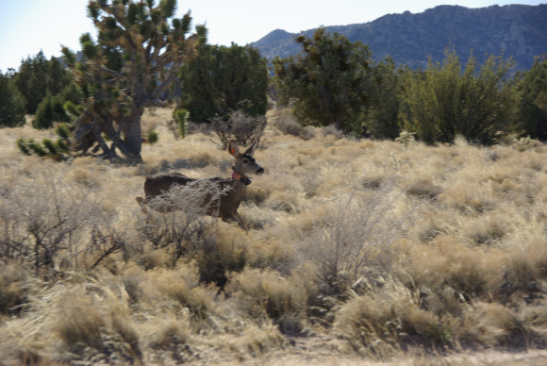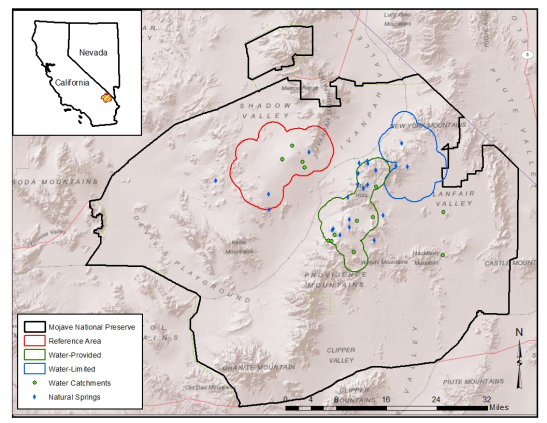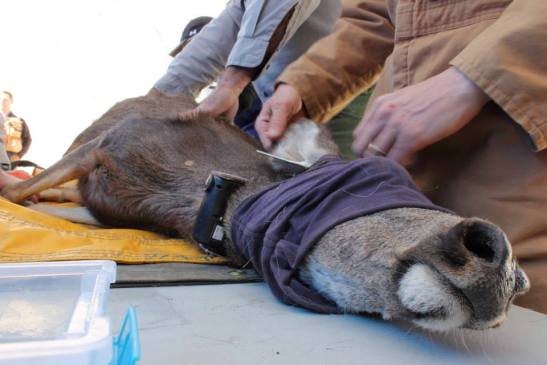Mojave Mule Deer Project
In 2004, National Park Service planned to remove artificial water developments from the Mojave National Preserve when cattle ranchers moved out of the preserve. The California Department of Fish and Game and several conservation partners challenged well removal because the importance of water provided by man-made wells was unknown. Twelve water developments have been reactivated in a study looking at the importance of water provisioning to mule deer and other wildlife.
East Mojave Water and Mule Deer Project (2007-Present)
By Dr. Kelley Stewart –
The Mojave National Preserve in San Bernardino County, California was inducted into the National Park Service (NPS) in 1994. Previously, the Bureau of Land Management had managed the land, and the NPS had planned to remove the water wells traditionally used for cattle ranching. In 2004, the California Department of Fish and Wildlife (CDFW), along with several conservation partners, questioned the effect that removal of the permanent water sources may have on the resident mule deer population.
The East Mojave Water and Mule Deer Project is an ongoing 10-year investigation partnered by the SCI Foundation, University of Nevada Reno, CDFW, and the NPS. This project focuses on the effects of availability to permanent water sources on the adult and juvenile mule deer populations on the Mojave National Preserve. Dr. Kelley Stewart and her team at the University of Nevada, Reno have been conducting this research for the span of the project. Thus far, they have evaluated the effects of availability of water on adult movements, selection of resources, and survival within the study areas. More recently, the project has focused on fawn survival and recruitment as an indicator of the overall population level effects. The team will be capturing an additional 32 adult deer in February 2016 to monitor their survival and movements as well as monitoring survival and recruitment of the fawns. Dr. Stewart’s third graduate student on the project, Levi Heffelfinger, will be aiding in collecting a fourth year of fawn capture and survival data this upcoming summer on the preserve.
While this project is ongoing, some of the information collected has already been evaluated. This project has shown that mule deer will have smaller home-ranges when water is permanently available. Additionally, adult survival seems to be affected by drought conditions, which place the highest strain on the animals during the pregnancy period. Juvenile survival has shown to be very low in the first few weeks of life and selection of birth sites tend to be closer to sources of water. The research team is excited to see what results may come from this past year’s above average rainfall in addition to this year’s expected increase in rainfall.
After this summer of fawn capture, the team hopes to hit their goal of a total of 100 fawns captured throughout the study. This large sample size should help in identifying the major underlying factors influencing fawn survival beyond the water treatment areas. The study sites for this project vary in vegetation and terrain, which may be a few of many influences affecting survival and the vulnerability of fawns.
A female mule deer is captured, radio-collared and tested
The effects on establishing permanent water sources for large game or even all wildlife has yet to be well understood. The results of this long term project will allow the wildlife managers in the Mojave National Preserve and many similar habitat types to understand the importance of provisioning water.
Project collaborators include: University of Nevada Reno, Safari Club International, California Department of Fish and Wildlife, and the National Park Service.
For more information, visit the National Park Service Mojave National Preserve website

Since 2000, SCI Foundation has provided more than $80 million to promote science-based conservation through wildlife research, capacity building in governments, youth and teacher education, and humanitarian programs that show the importance of the hunting community in society around the world. Growth of SCI Foundation has continued to gain momentum through charitable donations from SCIF and SCI members. Throughout the world, SCI’s approximately 50,000 members and 190 chapters contribute time, talent, and financial support to local, national, and international projects.





